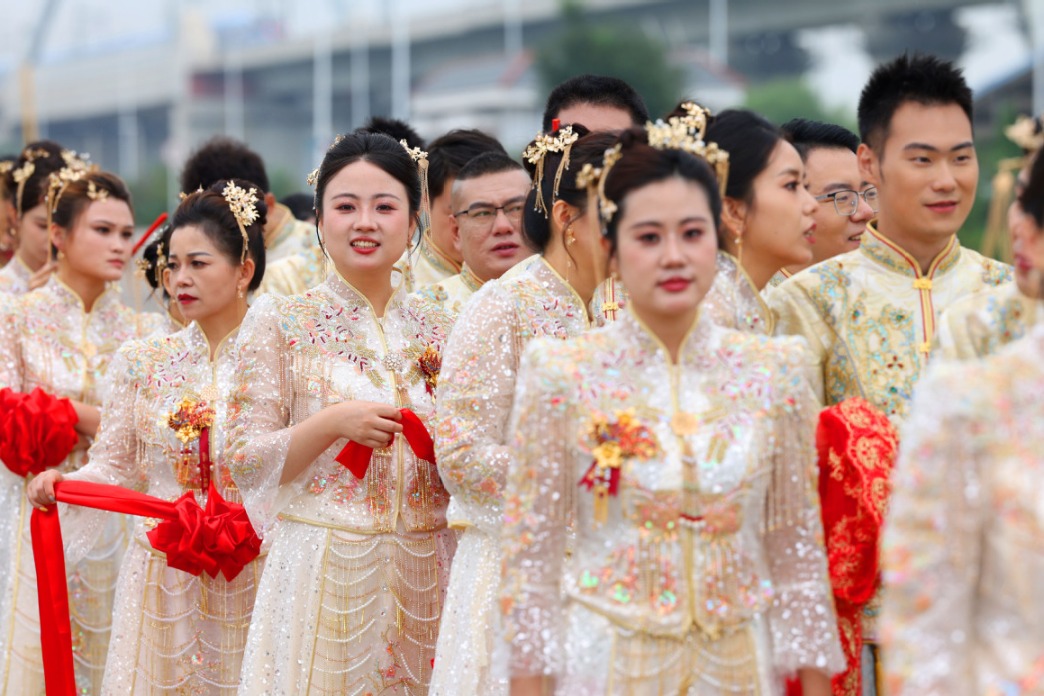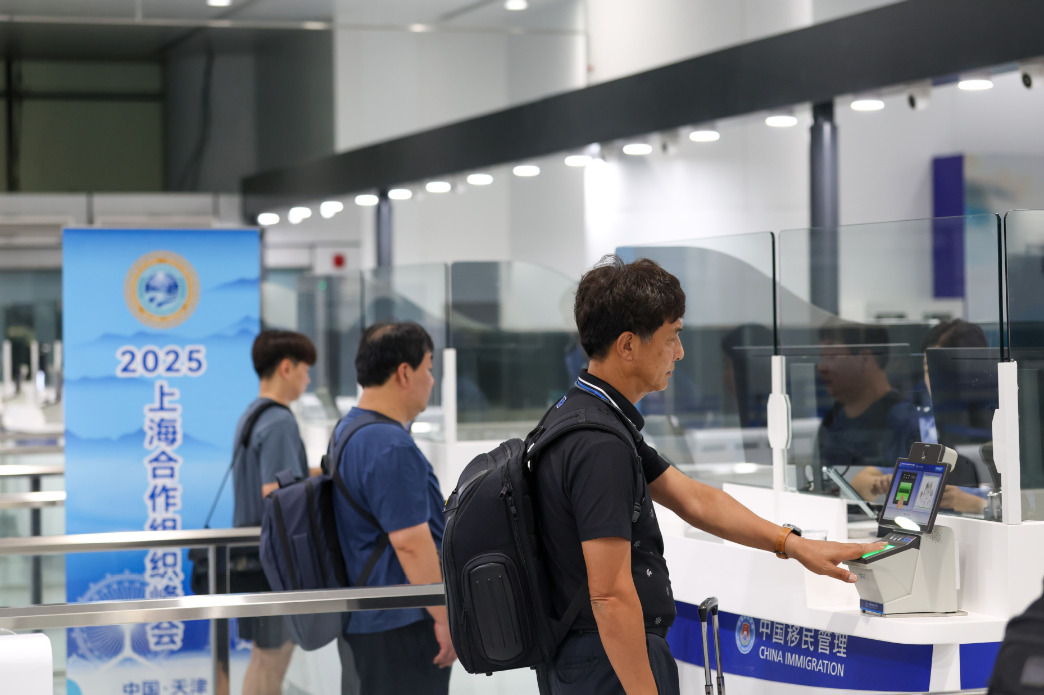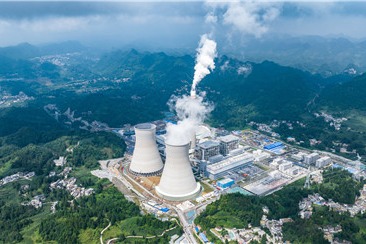The answer to climate change


Carbon capture, utilization and storage has emerged as a worldwide practice to check greenhouse gas emissions amid global warming. As part of the process, a Hong Kong scientist is testing out how carbon dioxide technology could be use to reshape industries and for space exploration. Shadow Li reports from Hong Kong.
Hong Kong nanomaterials scientist Daniel Lau Shu-ping has a conflicting dual vision for his carbon dioxide-to-ethylene system — scaling it up for industrial use and shrinking it for space missions, potentially aiding in the exploration of Mars where CO2 is close to 96 percent in the atmosphere.
The innovation of turning greenhouse gas into ethylene is still at a nascent stage, but has been identified as a part of carbon capture, utilization and storage (CCUS) — a process of handling CO2 to prevent it from entering the atmosphere. Fueled by growing acceptance and technological progress, the process has gained traction in many countries and regions as a weapon to combat global warming and achieve carbon neutrality, especially in hard-to-abate industries like steel, chemicals and cement which are difficult to decarbonize.
Ethylene — a vital chemical primarily used in the production of plastics, bottles, bags and containers — is traditionally made through the energy-intensive steam cracking of fossil fuels at up to 950 C. It is estimated that 260 million metric tons of CO2 are produced annually, against 160 million tons of global production of ethylene — the world's most-used petrochemical.
Lau's innovation offers a clean, energy-efficient solution for producing the carbon-heavy petrochemical. Lau's system captures CO2 and allows it to react with water in a steel cube using renewable electricity. While a European plant that uses the first-generation of such technology remains unprofitable, his improved second-generation technology shows promise.
First-generation systems have faced stability problems with their alkaline electrolytes reacting with CO2, forming carbonate blockages that require disassembly and clearance every 200 hours. Lau's improved design eliminates this problem, maintaining functionality for 2,000 hours at industrial-scale electricity in laboratory tests, while achieving better efficiency. "Industrial adoption requires gradual scaling," says Lau.
Adoption tussle
A State-owned Shanghai petrochemical plant has agreed to give Lau's CO2-to-ethylene project a trial run, spurred by discussions about introducing carbon taxes, but it requires the technology to be scaled up by 1,000 times.
"Nobody can achieve breakthroughs without profit pressure," Lau says. "Megawatt-scaling is the threshold for real interest."
The scientist plans to install his system in the third phase of Hong Kong's waste-to-energy facility. The first phase of the Integrated Waste Management Facilities is under construction on reclaimed land off Shek Kwu Chau, off the southern coast of Lantau Island. It is equipped with six incineration boilers and six flue gas treatment systems modules. It is expected to process 3,000 tons of municipal waste daily when it becomes operational this year, and export up to 480 million kilowatt-hours of surplus electricity annually, enough for 100,000 homes.
Studies are underway for the second phase of the IWMF at Tuen Mun's Tsang Tsui, which is set to double the handling capacity of the first phase.
With the tender for the project's second phase ending in about a month, Lau believes integrating his system in the third phase is a more plausible target.
The three facilities will support Hong Kong's goal of diverting 11,000 tons of daily landfill waste and eventually lead to two of the city's three main landfills ceasing operations before 2035.
Lau estimates that half a ton of CO2 is emitted for every ton of municipal waste handled in Hong Kong. He is aiming for approval from the government to collect data for assessing the actual emissions of the IWMF's first phase. "CO2 isn't typically classified as a pollutant (in Hong Kong). So, the government doesn't keep official records of its emissions," he says.
Lau will use CO2 level data collected by burning different waste types to refine his system. The information collected will also be vital for the technology's development and future global use, he says.
Waste-to-energy facilities with integrated CCUS technology like Lau's innovation offer ideal synergy by providing concentrated CO2 sources. Power plant flue gas, containing 20 to 30 percent CO2, presents particularly cost-effective emission reduction opportunities, he says.
Lau's renewable-powered system currently processes 100 tons of CO2 each year. After three decades of research, he is eager to see it implemented. However, despite the technology's potential, he has temporarily abandoned startup plans, citing an exhaustive hunt for investors, as well as the excessive resources needed. Instead, he is looking for business partnerships for direct installation, eyeing Chinese mainland petrochemical firms rather than Hong Kong power plants.
Sinopec — China's State-owned petrochemical bellwether — says it is interested in adapting Lau's technology (using a bronze catalyst) to produce not just ethylene, but also methanol and ethanol from CO2 — all technically feasible applications.
"Ethylene, which can be easily separated as a gas, is operationally efficient and in high demand in plastic production," says Lau, describing a circular process where recycled plastic is incinerated, with captured CO2 converted back to ethylene.
The cost of producing ethylene through CCUS is twice that of using traditional methods, but Lau expects mainland industries under looming emissions pressure to adopt it first despite holding patents in the United States and Europe.
While industrial use requires scaling up, Mars needs the opposite. Lau's team is miniaturizing the device to just 90 grams for space missions. Early tests aboard China's Shijian 19 satellite last year confirmed that the catalyst works in space. "If successful, this could join Mars expeditions after 2030," he says.
Betting big
China's Innovation Action Plan of Energy Technological Revolution (2016-30) lists CCUS among 15 key technologies. CO2 can be captured from industry, air or biomass, and then either sequestered or utilized through oil recovery, chemical or biological conversion. A China CCUS progress report issued in 2023 by the Global CCS Institute, the Administrative Center for China's Agenda 21 and Tsinghua University showed that biological and chemical utilization technologies for CO2 are at the industrial pilot stage, with CO2-to-synthetic-chemical-material having reached the industrial demonstration stage.
As of November 2022, China had about 100 CCUS projects in operation or in planning. Nearly half of them have been put in use, with more than 4 million tons of CO2 captured annually — a 33 percent increase, compared with 2021.
Most of these projects are in hard-to-abate industries, such as the cement and steel sectors. In particular, there are more than 40 CCUS demonstration projects in the pipeline, or in operation, in the oil and gas, coal chemical, petrochemical, ethanol and fertilizer production industries.
China's first batch of 47 low-carbon demonstration projects, listed last year, included six CCUS initiatives.
In November, Beijing Shougang Lanza Tech began building a pilot plant in Hebei province by converting steel and ferroalloy CO2 emissions into ethanol and microbial protein via biofermentation. The company has adopted its self-developed technology, which is in its second generation and is able to consume 0.5 tons of CO2 for each ton of ethanol produced, with the carbon fixation, or assimilation, rate reaching as high as 93.5 percent.
The enterprise, which launched the world's first such facility in 2018, currently operates four CO2-utilization plants in Hebei and Guizhou provinces as well as Ningxia Hui autonomous region, with an annual production capacity of 210,000 tons of ethanol and 23,200 tons of microbial protein.
The company's products are sold to domestic and overseas customers, and are further processed into sustainable aviation fuel, clean energy, daily-use perfumes, sports fashion, cleaning agents and packaging materials.
According to the firm's initial public offering application filed in Hong Kong in December, it reported having cut 1.4 million tons of CO2, utilizing 3 billion cubic meters of industrial off-gas, and achieving sales revenues of 592.6 million yuan ($ 82.8 million) in 2023.
Given the promising prospects of CCUS technology, Jeffrey Hung Oi-shing, CEO of Friends of the Earth (HK), calls it a "critical transitional solution", noting that current emission reduction efforts have fallen short of the Paris Agreement's 1.5 C goal. He emphasizes CCUS's long-term role for hard-to-abate sectors like steel and petroleum, noting that traded carbon credits cover 28 percent of global emissions.
He says Hong Kong universities should collaborate with enterprises in the Guangdong-Hong Kong-Macao Greater Bay Area in CCUS innovation and talent development, adding that government-led demonstration projects would spur private sector adoption.
Net-zero buildings
Li Jia, a professor at Lingnan University and an experienced CCUS researcher, is seeking funding to install her direct air capture technology into Hong Kong buildings, where CO2 levels are often high.
She has reduced costs from $400 to around $200 per ton of CO2 for the direct air capture technology. Her lab prototype captures 5 kilograms of CO2 per day; a pilot system which would capture 1 ton in a day is currently being developed.
Once upgraded to pilot-scale, a unit installed in a building will be able to consume the CO2 emitted, with "net-zero emissions", she says.
Generating electricity for buildings produces 50 percent of Hong Kong's carbon emissions, which peaked in 2014 and dropped 30 percent per capita (from 6.3 tons that year to 4.58 tons in 2023), according to the city's climate action plan progress report released in May. The SAR aims to halve its carbon emissions from the 2005 level by 2035 and achieve carbon neutrality before 2050.
Having worked in CCUS technology for years overseas, Li then became chief architect of a power plant project by China Resources Power Holdings Co in Shanwei, Guangdong province. The project has been in operation since 2019, converting 20,000 tons of CO2 annually into dry ice.
With Hong Kong's grid emitting 400 grams of CO2 per kilowatt-hour from natural gas and 780 grams from coal, Li says CCUS should be applied in new high-emission facilities. She suggests that carbon taxes should be imposed to offset the 15-20 percent cost increase for installing the new technology that deters private adoption.
However, former lawmaker Felix Chung Kwok-pan says Hong Kong lacks industrial emissions to justify carbon taxes, noting that 60 percent of local emissions come from power generation, which is solvable through cleaner fuels, 20 percent from the transport sector, and 10 percent from waste.
Going long
Inspired by US electric-vehicle giant Tesla's $10 billion carbon credit revenue since 2017, Chung set up the Hong Kong Carbon Trading Centre in 2022 to capitalize on growing demand.
By leveraging his background in the garment and textile manufacturing industry, which is often seen as the second-most polluting sector after oil and gas, Chung has helped about 20 Guangdong and Southeast Asia-based clothing factories to reduce emissions, generate credits, and connect with buyers, particularly in the European Union and US markets, where there are stricter carbon requirements.
With the EU's Carbon Border Adjustment Mechanism ending its transitional phase and being fully implemented next year, Chung says: "It's all about carrot and stick. Credits are the carrot and regulations are the stick."
Chung is helping a Bangladesh textile factory to certify carbon credits for 100,000 tons of CO2 reduction — a verification process that requires year-long data, third-party validation and often local government endorsement. However, the search for buyers has stalled because of economic uncertainties arising from Sino-US trade tensions.
"Carbon credits remain a secondary revenue stream for manufacturers," explains Chung. "When core businesses suffer from tariff wars, sustainability initiatives inevitably slow down." He remains optimistic about selling the credits next year despite the geopolitical challenges.
The voluntary carbon trading market, meanwhile, thrives as businesses buy diverse credits, originating from reforestation, renewables, ocean-related carbon and industrial footprint reduction, to offset stubborn emissions.
Chung notes that a Japanese fishing firm is seeking rare, costly-to-certify ocean credits, while airlines prefer in-sector credits recognized by the Carbon Offsetting and Reduction Scheme for International Aviation. "Buyers favor certain types of credits," he says.
Chung does not believe in adopting a globally unified standard, or a unified one in the Greater Bay Area, to drive Hong Kong's lofty goal of being a global carbon trading hub. Currently, the most widely used global standards include the Gold Standard, Verified Carbon Standard and the Kyoto Protocol's Clean Development Mechanism credits.
Current carbon prices average between $20 and $30 per ton in the US and 80 euros ($93.13) in the EU.
Chung, a carbon credit broker, expects to finalize a 300,000-ton deal this year with a Japanese oil firm, sourcing credits from Kenya, pending government approval.
Contact the writer at stushadow@chinadailyhk.com





































